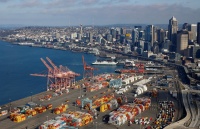U.S. lags in export financing arms race fueled by China: EXIM report

By Jonas Ekblom
WASHINGTON (Reuters) - China provided as much as $130 billion in government export financing support in 2018, dwarfing every other country and fueling a new export lending arms race, the U.S. Export-Import Bank said in a report on Friday.
"China stands in a league of its own as a provider of export and trade-related finance," EXIM said in its annual competitiveness report to Congress.
EXIM said that Beijing has brought a total government approach to export finance that has left the U.S. export financing agency far behind as it regains its full lending powers for the first time in nearly four years.
In the last full year that EXIM had complete lending powers, fiscal 2014, the agency provided $20.5 billion in financing support for $27.5 billion worth of U.S. exports.
The report described a substantially changed landscape in export finance since a 2015 fight in the U.S. Congress over EXIM's future nearly shut down the bank and left its lending powers sharply curtailed because of a lack of a board quorum.
Until May, when new board members were approved, EXIM was unable to finance or guarantee loans of more than $10 million, shutting it out of exports of large projects such as aircraft or power infrastructure.
During the fiscal year ended Sept. 30, 2018, EXIM authorized only $3.3 billion in financing, supporting $6.8 billion worth of U.S. exports, according to EXIM's most recent annual report.
China has in the meantime completely changed the playing field for government-backed export financing, EXIM said. The country's export financing agencies and state lending have been central to funding initiatives such as the Belt and Road infrastructure initiative and the "Made in China 2025" technology upgrade program.
China's practices have forced other countries to adjust their strategies so as not to lose access to important export markets, EXIM said. Other governments have started to mimic China and use their export credit agencies to "maximize the long-run export footprint" to establish customer bases abroad.
"Competition today is not simply about the volume or the terms and conditions of export credit support. Instead, competition now is principally focused on the innovative solutions that an entire government - not just its export credit agency - can offer," the agency said.
China's conventional medium and long-term export financing has also been trending upward for a decade and reached $39 billion in 2018, the report said.
On Thursday, EXIM's newly installed president, Kimberly Reed, told U.S. lawmakers that EXIM has about $40 billion worth of transactions at various stages in its pipeline that would support an estimated 230,000 U.S. jobs.
"But as we fully reopen, EXIM is reemerging to a dramatically more competitive environment in officially supported export credit as compared to when it was last fully functional," Reed told the U.S. Senate Banking Committee.
She added that there were now 113 foreign export credit agencies in other countries, up from 96 when she testified at her confirmation hearing in 2017, with more countries in the process of establishing ECAs.
The agency has been a popular target for conservatives, who have branded it as a provider of "corporate welfare" and "crony capitalism." The reinstatement of its lending powers is a boon for large U.S. manufacturers such as Boeing Co (NYSE: BA), General Electric (NYSE: GE) and Caterpillar Inc (NYSE: CAT), which can once again offer U.S.-government-backed financing for overseas customers.
(Additional reporting by David Lawder; Editing by Steve Orlofsky)
